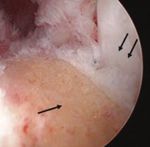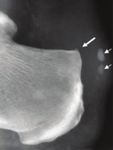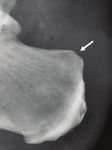Autologous Peripheral Blood Stem Cell Therapy for Chronic Achilles Tendinopathy: Report of Three Cases
←
→
Page content transcription
If your browser does not render page correctly, please read the page content below
22-CR8-167_OA1 23/07/2022 1:06 PM Page 150
Malaysian Orthopaedic Journal 2022 Vol 16 No 2 Saw KY, et al
doi: https://doi.org/10.5704/MOJ.2207.022
Autologous Peripheral Blood Stem Cell Therapy for
Chronic Achilles Tendinopathy: Report of Three Cases
Saw KY1, MCh Orth, Low SF2, MMed Rad, Ramlan A3, BSc, Dawam A3, MSc, Saw YC3, GCE A,
Jee CSY3, PhD
1
Department of Orthopaedic Surgery, Kuala Lumpur Sports Medicine Centre, Kuala Lumpur, Malaysia
2
Department of Radiology, Kuala Lumpur Sports Medicine Centre, Kuala Lumpur, Malaysia
3
Stem Cells Research and Development, Kuala Lumpur Sports Medicine Centre, Kuala Lumpur, Malaysia
This is an open-access article distributed under the terms of the Creative Commons Attribution License, which permits unrestricted use,
distribution, and reproduction in any medium, provided the original work is properly cited
Date of submission: 20th September 2021
Date of acceptance: 13th February 2022
ABSTRACT treatment. MRI scan and radiographs showed Haglund's triad
with Haglund deformity, retrocalcaneal bursitis and
The treatment of chronic Achilles tendinopathy (CAT)
insertional Achilles tendinopathy (Fig. 1a and 1b). This was
remains challenging. We report three cases of CAT treated
associated with calcifications in the retro-Achilles bursa
with autologous peripheral blood stem cells (PBSCs),
(Fig. 1c). Autologous PBSCs were harvested before surgery.
following principles developed for chondrogenesis of the
The details of the harvesting procedure and cell preparation
knee joint. Outcome measurement with a minimum of one
are outlined in our previous publication2. He underwent
and a half years follow-up showed significant improvement
surgery with removal of the calcified loose bodies in the
of Victorian Institute of Sport Assessment-Achilles
retro-Achilles bursa, arthroscopic burring of the Haglund
questionnaire (VISA-A) scores, with reduction of tendon
deformity (Fig. 1d) and multiple needling (23G needle) into
thickness and inflammation on MRI scan.
the inflamed Achilles tendon. Immediately after the multiple
needling, 8mL aliquot of thawed cryopreserved PBSCs were
Keywords:
mixed with 2mL hyaluronic acid (HA) [Hyalgan; Fidia
chronic Achilles tendinopathy, tendinitis, peripheral blood
Farmaceutici, Abano Terme, Italy] and injected into the
stem cells, VISA-A scores
inflamed Achilles tendon. At four subsequent weekly
intervals, the identical PBSCs plus HA mixture were injected
into the same area under aseptic conditions while sedated.
INTRODUCTION
Physiotherapy with ultrasound, transcutaneous electrical
Chronic Achilles tendinopathy (CAT) is debilitating and nerve stimulation and joint mobilisation commenced one day
causes prolonged pain and disability. As the Achilles tendon after surgery and he mobilised with a lower leg walker
is relatively avascular with a slow healing potential, overuse (Aircast ankle boot), progressing from partial to full weight
injury leads to repeated micro-tears of the tendon, resulting bearing in six weeks. Muscle strengthening and stationary
in chronic tendinopathy. The ideal treatment of CAT remains bike cycling commenced after six weeks. At month three and
elusive. Non-surgical and surgical methods have not been six following surgery, three additional weekly injections
entirely curative and often relapse1. comprising 4mL thawed cryopreserved PBSCs and 2mL HA
were given. MRI scan following surgery showed repair and
We pioneered chondrogenesis with autologous peripheral regeneration of the CAT with reversal of the pathology to
blood stem cells (PBSCs), addressing massive knee chondral signal normality (Fig. 1e-1h).
defects2. Following the principles developed for
chondrogenesis, we report the results of applying PBSCs The second case was a 41-year-old woman with one year’s
therapy to address CAT. history of pain and swelling over the right Achilles tendon.
MRI scan as shown (Fig. 2a and 2b) revealed non-insertional
Achilles tendinopathy with fusiform thickening associated
CASE REPORTS with hyperintense signal. The fusiform swelling with
inflammatory changes over the Achilles tendon resolved
The first case was a 59-year-old man with a five years’
following multiple needling into the Achilles tendon and a
history of CAT, following unsuccessful conservative
Corresponding Author: Khay-Yong Saw, Orthopaedic Surgery, Kuala Lumpur Sports Medicine Centre, 47, Jalan Dungun, Bukit Damansara,
50490 Kuala Lumpur, Malaysia
Email: sportsclinic@hotmail.com
15022-CR8-167_OA1 23/07/2022 1:06 PM Page 151
Stem Cells for Achilles Tendinopathy
Table I: Patient demographics and VISA-A scores from pre- to post-surgical follow-ups in all three cases.
Case Gender Age at Duration of Period of VISA-A scores
surgery symptoms follow-up Pre-surgical Post-surgical Improvement
(years) (months) (years)
1 Male 59 60 6.0 31 100 69
2 Female 41 12 9.5 41 97 56
3 Male 49 36 1.5 38 72 34
Mean - 50 36 5.7 37 90 53
(a) (b) (c) (d)
(e) (f) (g) (h)
Fig. 1: (a) Sagittal and (b) axial proton density fat suppressed (PDFS) MR images of the right ankle showing Haglund's triad with
Haglund deformity (short white arrow), retrocalcaneal bursitis (black arrow) and insertional Achilles tendinopathy (double white
arrows). Hyperintense signal and interstitial split tears were noted at the distal Achilles tendon (long white arrows). (c) Lateral
ankle radiograph shows Haglund deformity (white arrow) and calcifications in the retro-Achilles bursa (small arrows). (d)
Posterior ankle arthroscopic view from the medial portal showing the Haglund deformity (black arrow) and a 4-mm arthroscopic
burr (white arrow) from the lateral portal. (e, f) Similar MR images as in (a, b) six years following surgery with burring of previous
Haglund deformity (short white arrow), showing repair and regeneration of the Achilles tendon with reversal of the pathology
to signal normality (long white arrows). (g) Lateral ankle radiograph following arthroscopic burring of the Haglund deformity
(white arrow) and removal of the calcifications in the retro-Achilles bursa. (h) Arthroscopic view similar to (d) following
arthroscopic burring of the Haglund deformity (black arrow) revealing the previously impinged Achilles tendon (double black
arrows).
five-weekly injection of PBSCs plus HA (Fig. 2c and 2d). 3 were non-insertional CAT, hence no burring of the Haglund
The pre-operative preparation, intra-operative injections and deformity was required.
post-operative physiotherapy regime were similar to the first
case. No further additional injections at months three and six Victorian Institute of Sport Assessment-Achilles
were required as compared to the first case because of questionnaire (VISA-A) score was used as patient outcome
significant clinical and radiological improvement. scores for each of the cases reported here at final follow-up
(Table I). The VISA-A score has been shown to be reliable
The third case was a 49-year-old man with a three years’ for assessing functional outcome relating to CAT treatment3.
history of CAT. Sagittal and axial proton density fat It is based on a numeric score of 0 to 100 points, with
suppressed MR image of the right ankle showed non- asymptomatic subjects expected to score 100 points. Our
insertional Achilles tendinopathy with intrasubstance three cases showed post-operative scores above 70,
hyperintense signal. This was treated with procedures and indicating scores comparable to healthy subjects4. There
post-operative regime similar to the second case. Cases 2 and were no documented infections or major adverse events.
15122-CR8-167_OA1 23/07/2022 1:06 PM Page 152
Malaysian Orthopaedic Journal 2022 Vol 16 No 2 Saw KY, et al
(a) (b)
(c) (d)
Fig. 2: (a) Sagittal short tau inversion recovery (STIR) MR image and (b) axial T2W MR image of the right ankle showing non-insertional
Achilles tendinosis with fusiform thickening and hyperintense signal of the Achilles tendon (white arrows). (c) Sagittal STIR MR
image and (d) axial T2W MR image showing the Achilles tendon resuming its normal signal intensity and appearing less
thickened compared to previous study (white arrows) at six months following multiple needling and a five-weekly injections of
PBSCs plus HA.
DISCUSSION Comparing with the VISA-A score in pre-surgical patients,
the mean age of our three patients was slightly older at 49.6
Autologous PBSCs therapy is a viable option for the
as compared to 44.3 years, the mean duration of symptoms
treatment of CAT. Objective evaluation by MRI scans
was longer at 36 as compared to 19.2 months and the mean
assessed the repair area non-invasively and documented
pre-surgical score was lower at 36.6 as compared to 44
satisfactory healing process, with no evidence of adverse
points4. All our three cases showed scores above 70 with an
abnormalities. This was accompanied by significant
overall increase beyond 28.9 points following surgery,
improvement of the VISA-A scores in all three cases.
indicating scores comparable to healthy subjects4. Two
patients (Cases 1 and 2) achieved a score of 100 and 97
The mean VISA-A score in non-surgical patients with
points at a follow-up period exceeding six and nine years,
Achilles tendinopathy was 64 (59-69) with a mean age of
respectively (Fig. 3 and Table I). This suggests that PBSCs
42.3 years, in pre-surgical patients 44 (28-60) with a mean
therapy has the ability to be curative and regenerative in
age of 44.3 years, and in control subjects it exceeded 96 (94-
nature and that long term results are sustainable.
99)4. Following treatment, a score above 70 can be
considered satisfactory (Fig. 3)4. An overall increase of
The use of platelet-rich plasma for treating CAT has gained
VISA-A score of 28.9 points showed significant
tremendous interest lately, but high level of evidence studies
improvement as reported by Madhi et al in systematic
did not show a significant efficacy and the evidence
reviews1.
15222-CR8-167_OA1 23/07/2022 1:06 PM Page 153
Stem Cells for Achilles Tendinopathy
Fig. 3: Diagram showing VISA-A scores of different groups; namely pre-surgical, non-surgical, healthy and active individuals, and post-
surgical. The upper bars represent the scores from our three-case series. The lower bars indicate reported scores, whereby the
dotted line is the threshold score that indicate treatment success (Robinson et al, 2001)4.
supporting it is limited1. Anz et al5 recently concluded that As seen in our three reported cases, autologous PBSCs seem
PBSCs showed proliferative potential and were pluripotent. to be a promising orthobiologics for the repair and
Thus, PBSCs has the ability to repair and regenerate all the regeneration of CAT and likely applicable to the other
native cellular types of the musculoskeletal system (MSK). aspects of the MSK5. A future randomised controlled clinical
Applying the same principles we developed for knee trial along the direction we have embarked similar to knee
chondrogenesis with PBSCs2, we believe that the pathway to chondrogenesis with PBSCs2 would be ideal to further
the repair and regeneration of CAT requires three key validate this early concept.
principles, namely: (1) Creating fresh injury (by multiple
needling), (2) Cellular therapy with multiple PBSCs plus HA
injections (to provide enough cells to create matrix CONFLICT OF INTEREST
substance, release growth factors and differentiate into
The authors declare no conflicts of interest in this case.
various components of the MSK), and (3) Functional
stimulation with tailored physiotherapy (allows the stem
cells to differentiate in the native functional environment,
thus regenerating the desired tissue type).
15322-CR8-167_OA1 23/07/2022 1:06 PM Page 154
Malaysian Orthopaedic Journal 2022 Vol 16 No 2 Saw KY, et al
REFERENCES
1. Madhi MI, Yausep OE, Khamdan K, Trigkilidas D. The use of PRP in treatment of Achilles Tendinopathy: a systematic review
of literature. Study design: systematic review of literature. Ann Med Surg (Lond). 2020; 55: 320-6. doi:
10.1016/j.amsu.2020.04.042
2. Saw KY, Anz A, Ng RC, Jee CS, Low SF, Dorvault C, et al. Arthroscopic subchondral drilling followed by injection of peripheral
blood stem cells and hyaluronic acid showed improved outcome compared to hyaluronic acid and physiotherapy for massive knee
chondral defects: a randomized controlled trial. Arthroscopy. 2021; 37(8): 2502-17. doi: 10.1016/j.arthro.2021.01.067
3. Iversen JV, Bartels EM, Langberg H. The victorian institute of sports assessment - achilles questionnaire (visa-a) - a reliable tool
for measuring achilles tendinopathy. Int J Sports Phys Ther. 2012; 7(1): 76-84.
4. Robinson JM, Cook JL, Purdam C, Visentini PJ, Ross J, Maffulli N, et al. The VISA-A questionnaire: a valid and reliable index
of the clinical severity of Achilles tendinopathy. Br J Sports Med. 2001; 35(5): 335-41. doi: 10.1136/bjsm.35.5.335
5. Anz AW, Torres J, Plummer HA, Jee CSY, Dekker TJ, Johnson KB, et al. Mobilized peripheral blood stem cells are pluripotent
and can be safely harvested and stored for cartilage repair. Arthroscopy. 2021; 37(11): 3347-56. doi:
10.1016/j.arthro.2021.04.036
Cite this article:
Saw KY, Low SF, Ramlan A, Dawam A, Saw YC, Jee CSY. Autologous Peripheral Blood Stem Cell Therapy for Chronic Achilles
Tendinopathy: Report of Three Cases. Malays Orthop J. 2022; 16(2): 150-4. doi: 10.5704/MOJ.2207.022
154You can also read


























































